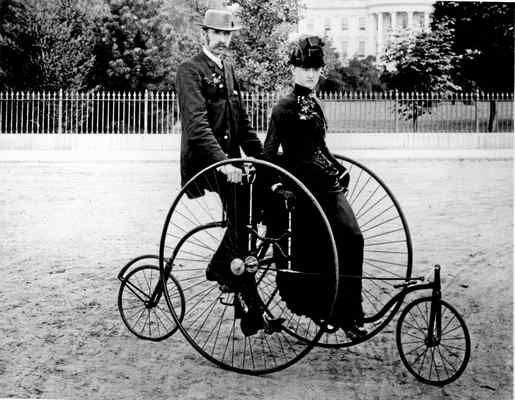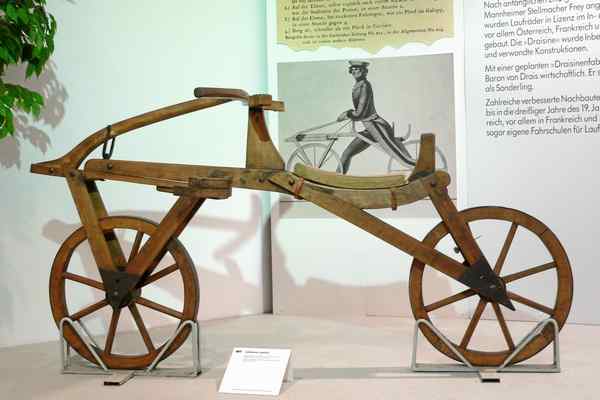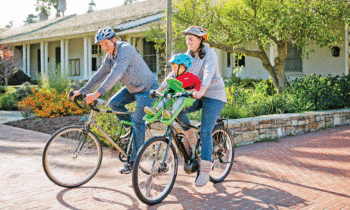
Decades after Karl Drais launched his primitive bicycle, the penny-farthing — also known as the high wheeler — it became a symbol of the late Victorian era. Its popularity in the 1870s also coincided with the birth of cycling as a sport. (Courtesy of Wikimedia Common)
By Karen Kefauver, Spin City

Two hundred years ago in Germany, Baron Karl von Drais demonstrated his most famous invention: the laufmachine — or “running machine,” the prototype for the modern bicycle. (Jasiel Azevedo — Contributed)
The road to inventing the bicycle was a bumpy one for Karl Drais, the German aristocrat who launched the “running machine” in 1817. His wooden, two-wheeled contraption without pedals evolved into the modern bicycle.
This year marks the 200th anniversary of the date on which Karl Friedrich Christian Ludwig Freiherr Drais von Sauerbronn took his new invention out for a ride — or a “run.”
Today, I’m dedicating this column to the bicycle bicentennial. I pay tribute to Drais, whose invention marked a milestone in innovation that led to today’s wide variety of bicycles. Without him, my life — and certainly many of yours — would be very different.
Born in 1785, Baron Karl Drais became one of the most prolific inventors of the 19th century, designing the first typewriter with a keyboard, an early stenograph machine and the meat grinder, among other things.
But it was his passion for developing horseless transportation that led to his most famous invention, the Laufmaschine, or “running machine.”
Loathed by his fellow aristocrats for his liberal politics and the survivor of an assassination attempt, Drais designed a muscle-powered replacement for horses that would help people move faster than walking or riding in a coach. Despite his democratic philosophy, his machine was so expensive few could afford it, leading to yet another one of its nicknames: “dandy horse.”
According to an article by UK cycling historian Sheila Hanlon, “To propel the machine, the rider ran his feet along the ground, coasting between strides as the machine gained velocity, reaching speeds averaging five to six miles per hour. To brake, the rider pulled a cord that stopped the back wheel.”
In 1817, astride his 50-pound invention, Drais rode approximately eight miles in an hour — faster than the horse-drawn coach could make the same trip. His debut ride, in southwest Germany, was met with buzz in the press. A few months later, Drais created a huge sensation when he rode 60 kilometers in four hours.
While I rarely burst into song on my bike, I do sing the praises of Drais, who died penniless. Fortunately, his invention lived on and he earned the recognition he deserved.
As I ponder the evolution of the bicycle, ranging from the “bone shaker” and the “high wheeler” to modern full-suspension mountain bikes and electric bicycles, I see how intricately my story is interwoven with cycling.
During my 24 years living in Santa Cruz, bicycling has formed the framework for my life socially, professionally, athletically and even politically. I’ve made lasting friendships from my early involvement with Bike to Work (which just celebrated its 30th birthday); I’ve written hundreds of stories about bicycling during the past two decades as a freelance journalist (my stories about bicycling in Montana and Copper Canyon were the most popular); and, of course, biking is my favorite way to get around town and out into nature.
In addition, as a member of the bike community, I’ve grown into an advocate for urban planning and infrastructure that encourages people to ride bikes for fitness and to protect the environment.
I’m grateful for a mode of transportation that has profoundly shaped my life.
Thank you, Karl Drais, for getting things rolling.
Karen Kefauver (karenkefauver.com) is a freelance writer who covers sports and travel and is based in Santa Cruz. Her Spin City bike column appears monthly and was launched in 2009.


